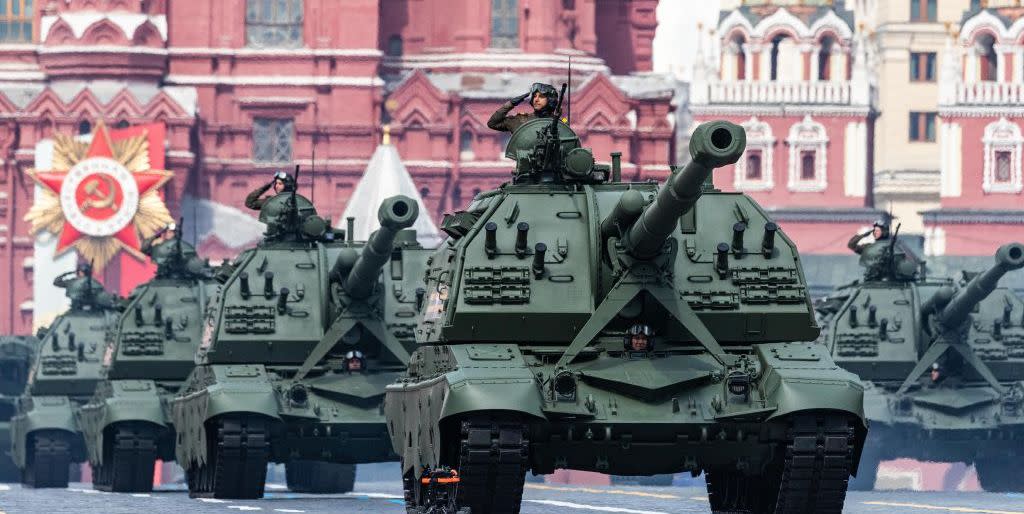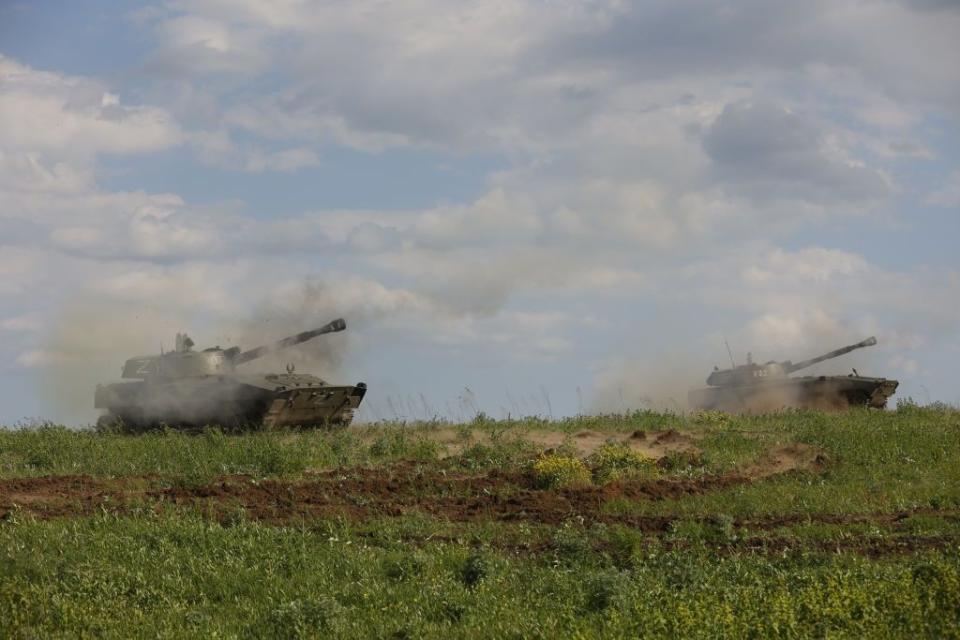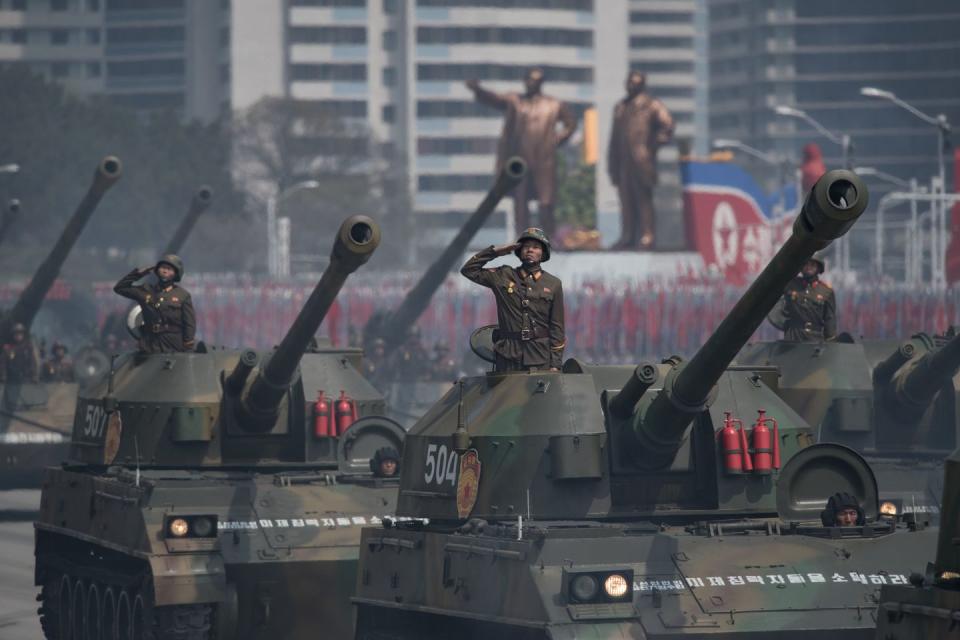To Keep Its Invasion of Ukraine Going, Russia Has Turned to North Korea for More Weapons

U.S. intelligence claims that Russia has agreed to purchase rockets and artillery shells from North Korea.
The report suggests that Russia’s heavy use of artillery is seriously cutting into its stockpile and it cannot sustain the war on its own much longer.
The purchase, along with shipments of low-tech drones from Iran, implies that Russia is running low on key weapons.
Russia is purchasing millions of artillery shells and rockets from North Korea, U.S. intelligence has concluded. Moscow, which is expending tens of thousands of shells a day in its invasion of Ukraine, has apparently run so low it is now set to buy them from the repressive regime. The invasion, well into its sixth month, has gone on much longer than Russia originally planned, and Russian forces are now running out of critical munitions.
The Washington Post, citing recently declassified U.S. intelligence, reports that Russia is buying “millions” of short-range rockets and artillery shells from North Korea. The Post quoted an unnamed U.S. official stating, “We expect Russia could try to purchase additional North Korean military equipment going forward.”

The report does not mention what specific kind of munitions Russia is buying from North Korea, but it’s likely buying 122mm shells for its 2S1 122mm self-propelled howitzers, typically deployed at the battalion tactical group and brigade levels, and 152mm shells for its 2S19 MSTA-S 152mm self-propelled howitzers. The 2S1 has no equivalent in the NATO armies, but the 2S19 is similar to the American M109A7 Paladin and German Panzerhaubitze 2000 155mm self-propelled howitzers.
Russian military doctrine emphasizes heavy artillery bombardments of enemy forces to enable maneuver, suppressing enemy positions to enable armor and infantry attacks to succeed. According to Ukrainian military officials, Russian Ground Forces and Moscow’s proxy armies are firing 40,000 to 60,000 rockets and shells a day. Over the 201 days since the invasion started, that results in at least eight million and up to 12 million munitions expended—so far.

Russian leader Vladimir Putin and his generals originally believed that the invasion of Ukraine would take just three days. Russian paratroopers were originally tasked to secure Gostomel airport near Kyiv and quickly capture Ukraine’s capital city. This would have led to a collapse of Ukraine’s civilian—and eventually military—leadership and end organized resistance in the country. Instead, Ukrainian forces recaptured Gostomel, forced Russia to abandon its march on Kyiv, and recast the war as a long, hard war of attrition in the country’s east.
The war has now taken 198 days longer than originally projected, with no clear ending in sight. Russia is known to have prodigious stocks of ammunition, most of it dating back to the Cold War, but eight million artillery shells would put a dent in even the most prepared armies. Russia, unlike Western armies, also uses fewer precision-guided artillery shells, resulting in the need to saturate a target with many shells, when only a few precision shells would do.

North Korea is one of the most heavily militarized countries in the world. Despite a population of just under 26 million, it has the world’s fourth largest military with 1.2 million personnel under arms. Artillery is a major part of the Korean People’s Army’s (KPA) firepower, and the KPA fields an estimated 20,500 artillery pieces, including 5,100 multiple rocket launchers, 4,400 self-propelled artillery, and 7,500 mortars. The KPA has considerable stocks of artillery shells and rockets to not only blast a route through the Demilitarized Zone but also bombard the South Korean capital of Seoul.
North Korea uses many of the same artillery calibers as Russia, especially 122 millimeter Grad rockets and 152mm howitzer shells. These are different calibers than U.S. and NATO artillery, which typically uses 227mm rockets and 155mm howitzers shells. North Korea came to adopt Russian calibers when it was a Cold War Russian client state and built up vast reserves of war equipment in the event of a second Korean War.

The North Korean artillery sale is a mixed bag. On one hand, it shows how desperate Russia is to keep its war machine running; not only must Russia be close to emptying out its reserves of artillery shells, its military industrial complex cannot keep the guns firing on its own. It also shows that countries like China, which also manufacture 152mm artillery shells, are not interested in crossing western sanctions against Russia and supplying it with arms. Finally, reducing North Korea’s stockpile of artillery shells makes it vulnerable to supply shortages in a war of its own.
On the other hand, more artillery shells will prolong the war in Ukraine and make it more difficult for Ukrainian forces to take back their own country. North Korea, with an economy a third the size of Delaware’s, could steer the proceeds from the sale into what many consider their most dangerous weapons: nuclear weapons. These weapons are pointed at North Korea’s enemies, particularly the United States.
It’s unlikely that Russia buying weapons from North Korea, let alone Iran, was on anyone’s bingo card for 2022. Russia’s hungry war machine is pushing it to desperate measures. Moscow may have a surprise in store for it though: in 2010, after North Korea bombarded the South Korean island of Yeonpyeong, authorities discovered up to 25 percent of the rockets were duds. That’s a high failure rate for a fairly simple rocket.
You Might Also Like

